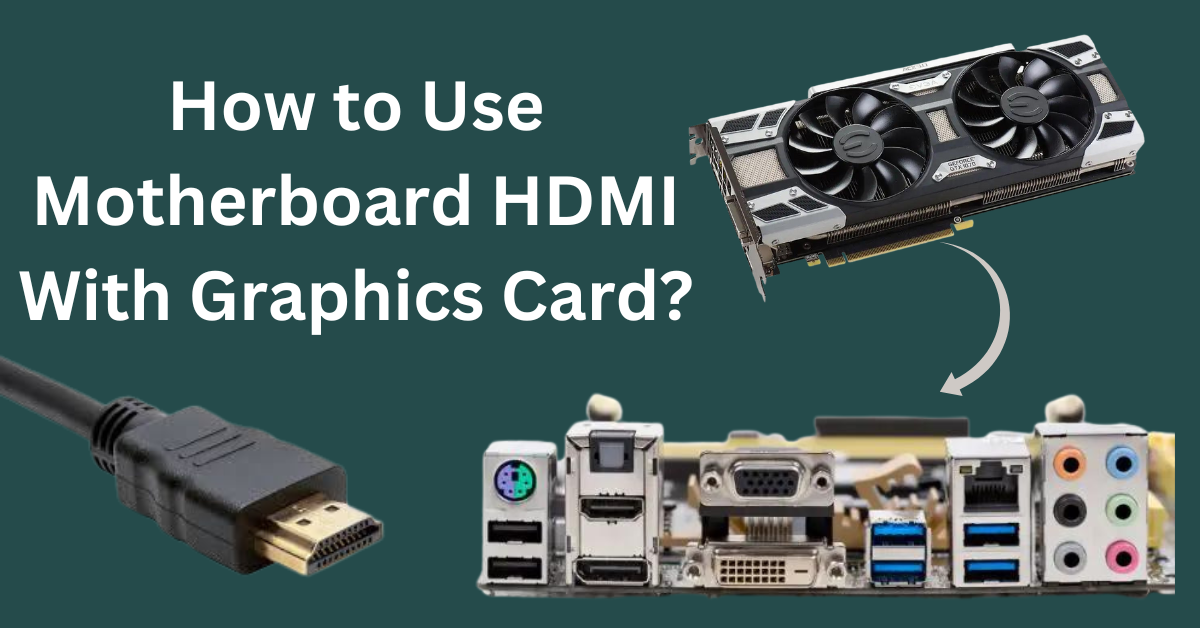Do you need help using your motherboard’s HDMI port with your graphics card? If so, don’t worry – you’re not alone! This blog post will walk you through the steps you need to take to get everything working properly. We’ll also provide some tips on how to troubleshoot any potential issues. So without further ado, let’s get started!
What Is Motherboard HDMI?
Motherboard HDMI is a type of digital video output that comes integrated directly into your motherboard. It is most commonly used to connect a PC to an external monitor or TV, allowing you to view content in high definition.
Types of Connectors
When using motherboard HDMI, you must use the correct type of connector. Most motherboards come with an HDMI port compatible with Type A and Type C connectors. However, some older motherboards may only be compatible with Type A connectors. It’s important to check your motherboard’s manual for compatibility information before attempting to connect anything.
Step By Step Guide On How To Use Motherboard HDMI With Graphics Card
The first step in using your motherboard’s HDMI port with a graphics card is to ensure that your graphics card supports it. Some cards may not have the necessary connections required to use this feature, so it’s always best to double-check beforehand. Once you’ve determined that your card does support motherboard HDMI, the next step is to make the physical connection.
Most motherboards have both an HDMI port and a DisplayPort connector, so you’ll need to identify which one is which before connecting your graphics card. If your graphics card has a DisplayPort connector, you can connect directly to the motherboard’s HDMI port. However, if your graphic card only has an HDMI connector, you will need an adapter to convert the signal from DisplayPort to HDMI.
Once you’ve connected everything properly, all that’s left to do is install your drivers and configure your display settings in Windows or whatever operating system you’re using. After this is done, your monitor should be able to detect the signal coming from both the integrated GPU and your dedicated graphics card.
You can now enjoy a fully functional multi-monitor setup, with the ability to switch between multiple displays depending on the task at hand.
Tips For Using Motherboard HDMI With Graphics Card
1. Ensure the correct drivers are installed for the motherboard and graphics card. This will ensure proper communication between the two components and that everything works as intended. You can download the latest driver updates from the manufacturer’s website for both components.
2. Connect your monitor or TV to the appropriate port on your graphics card using either an HDMI or DisplayPort cable, depending on what port is available on your device.
3. Use the integrated graphics in your motherboard to power the display by connecting a monitor cable to the HDMI port on the back of your computer.
4. Open your computer’s BIOS settings and switch the primary display from “Integrated Graphics” to “Discrete Graphics.” This will enable you to use the dedicated graphics card for all graphical operations.
5. Once you have made this change, save your changes and restart your computer. When it boots up, you should now be able to view content via either device connected via HDMI or DisplayPort, depending on the cable used.
6. If necessary, adjust the resolution settings in Windows Display Settings so that both monitors display correctly at their native resolutions.
7. You can now simultaneously use both devices connected via HDMI or DisplayPort. Enjoy your new multi-monitor setup!
8. Finally, if you ever need to disconnect and reconnect either device, make sure to reset the graphics card settings in BIOS/UEFI before booting the computer again. Otherwise, you may experience issues with your display setup. That’s all there is to use your motherboard HDMI and graphics card for multiple displays!
Troubleshooting:
If you experience any issues with your display setup, here are some tips that may help:
1. Check the device connections – ensure both monitors are securely connected to the graphics card and motherboard ports.
2. Adjust the resolution settings – try different resolutions in Windows Display Settings until all monitors display correctly at their native resolutions.
3. Update your drivers – ensure you have installed the latest graphics card and motherboard drivers.
4. Check BIOS/UEFI settings – ensure you’ve enabled multiple monitors in BIOS/UEFI before booting the computer again.
5. Try different cables – if all else fails, try using a different cable to connect a monitor to the graphics card or motherboard port.
Frequently Asked Questions
Q: Is it possible to use a graphics card HDMI with a motherboard?
A: Yes, it is possible. You must connect the graphics card and motherboard outputs to your monitor using an appropriate cable. You may also need to adjust the settings after connecting multiple monitors to different ports.
Q: Can I use a higher-resolution display on my graphics card than on my motherboard?
A: Yes, some dedicated graphics cards have multiple ports that support higher-resolution displays than those supported by the motherboard’s ports. This means you can use a higher-resolution monitor if desired.
Q: Is any special setup required when using a combination of motherboards and graphic cards?
A: Yes, you will need to adjust your display settings when using the motherboard and graphic card outputs for multiple monitors. This includes adjusting the resolution, refresh rate, and other relevant settings. Additionally, if you plan to use different types of cables for each monitor (e.g., HDMI vs. DVI), you may need to configure the ports so they can all be used with their respective cable type.
Q: Are there any performance benefits associated with using both a motherboard and graphics card?
A: Yes – using a motherboard and graphics card can improve performance in certain applications, such as gaming and video editing. This is because the graphics card can dedicate more resources to intensive tasks, while the motherboard can still handle basic computing tasks. Additionally, having a separate GPU will allow for smoother visuals on your displays if you are using multiple monitors.
Q: Is it possible to mix and match different types of connectors when combining a motherboard and graphics card?
A: Yes – as long as the cables you’re using are compatible with both components. For example, if you have an HDMI output on your motherboard and DVI ports on your graphics card, you can use both simultaneously. Make sure you’re using the correct cable for each device, and double-check compatibility before making any purchases.
Conclusion
Using your motherboard’s HDMI port with a graphics card can be tricky, but it is possible. With the steps outlined here, you should now have a better idea of how to get everything working correctly. If you still need help after following these steps, consult the manufacturer’s website for more detailed instructions or contact their customer support team for help. Good luck!



2 comments
Good day! I just want to offer you a big thumbs up for your excellent information you have got here on this post. Ill be coming back to your blog for more soon.
Excellent article. I certainly love this website. Keep writing!